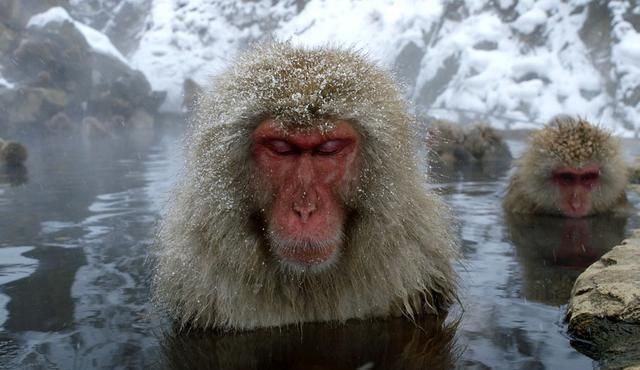The Japanese macaque (Macaca fuscata) or snow monkey is a native species of Japan. It is a New World Monkey. The macaque is thought to survive in extreme cold climates where the land is covered with snow all year round. It is not possible for other primates to live in such cold weather.
Japanese Macaque Facts
Anatomy
- The adult males stand 570.1 mm (22.44 in) while females stand 522.8 mm (20.58 in) at the shoulder height.
- Male macaques weigh up to 11.3 kg (25 lb) whereas females are 8.4 kg (19 lb) in average.
- The length of the tail is 92.51 mm (3.642 in) in males and 79.08 mm (3.113 in) in females.
- The weight of the Japanese macaque’s brain is 95 g (3.4 oz).
- They have a pinkish red face which is naked but the rest of the body is covered with dense yellowish hair. Thanks to the thick layer of hair that protects the animal from low temperatures. The temperature falls down to as low as minus 20 degree Celsius.
- They will walk on all four.
- Japanese macaques are semi-terrestrial species with males are seen on the ground and females on the trees.
- They can also leap and are thought to be remarkable swimmers. Macaques are able to swim as much as half a mile.
- The average lifespan of males is 28 years and that of females is 32 years.
Distribution
- Japanese macaques live in the three Japanese islands; Kyushu, Honshu, and Shikoku.
- The isolated population is also found on the Shimokita Peninsula. The rest of the islands are home to a few macaque species.

Habitat
- They are likely to occupy subtropical habitats including subarctic forests in the northern part and on the mountainous part of its range.
- Japanese macaques also make homes in deciduous forests as well as on the broadleaf evergreen forests.
- Warm and cool temperate deciduous forests also provide ideal habitats for these monkeys.
Behavior
- Female macaques will remain in the group all their life while males go away once they attain maturity.
- Typically a single group consists of adult males and females but sometimes they make group comprising solely males.
- Male macaques are known to spend enough time in a group before they leave it for another group.
- The dominant monkey in the group is called alpha and when he dies the dominance goes to the following member.
- Japanese macaques are thought to produce calls like coos especially during feeding or traveling. The voices are meant not only to keep the group members intact but also to strengthen the social relations among females.
- The other members also respond to coos as coos.
- They are highly intelligent creatures.
- In captivity Japanese macaques mimic the human accents quite skillfully.
- They are diurnal and spend most of the daytime traveling. Macaques spend 23% of the daily time on feeding.
- They will sleep in trees as well as on the ground.
Feeding Ecology & Diet
- They have an omnivorous diet. Japanese macaque’s diet includes more than 200 species of plants.
- They consume barks, soil, and insects. Macaques living in the Yakushima Island are more apt to rely on fallen seeds, mature leaves, and fruits.
- Japanese macaques also eat ferns, soil, invertebrates, and other parts of plants.
- In summer, fruits make up most of the diet while in winter they rely on herbs.
- In the north, they will feed on nuts and fruits to prepare up for the winter when the food goes short.
- In Kinkazan, their diet consists of young leaves, seeds, fruits, and herbs.
- When the food is scarce, they will dig underground plants along with fish and soil.
Reproductive Biology
- Pairing male and female will mate, eat, and travel together but it only lasts 2 days.
- A single female mate with 3 – 4 males every season; even a male of lower rank can mate but the dominant male is most likely to do so since it guards the family well.
- A female is known to produce several different calls such as squawk, cackle, and cook. It typically gives to a single offspring and the birth occurs on the ground.
- The infants have dark brown hair on their skin. In the first 40 – 45 days, they will eat soft food. By seven weeks the infants go independent. The infants will spend first month on the mother’s back.
- Adult males rarely participate in grooming young monkeys—a job solely done by mothers. Males spend most of the time guarding family members.
- The young will start climbing in the next 3 – 4 months. The weaning period is 18 months.
- When infants reach the age of 2 years they begin associating themselves with males of other groups.
Conservation Status
Least Concern






Leave a Reply